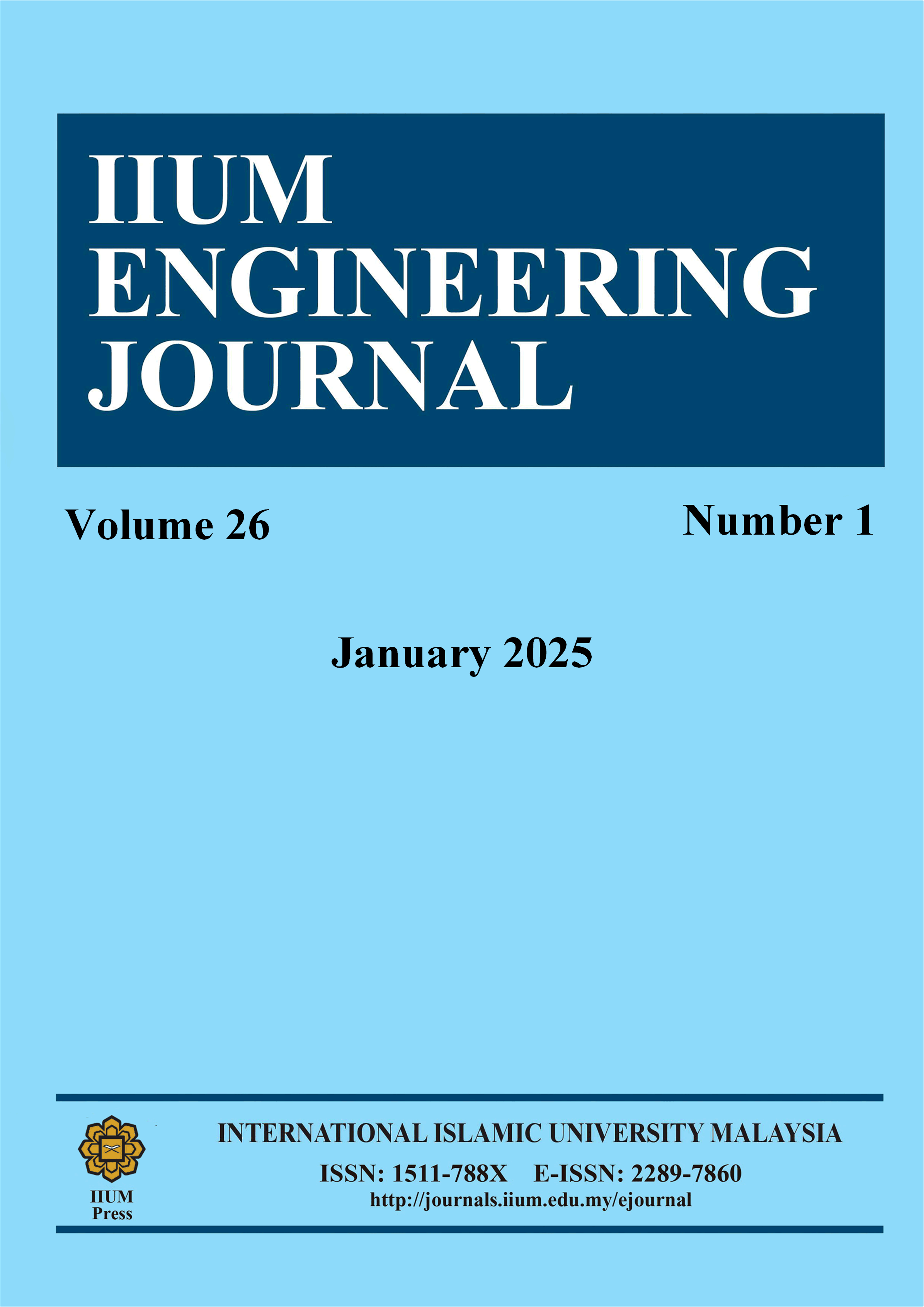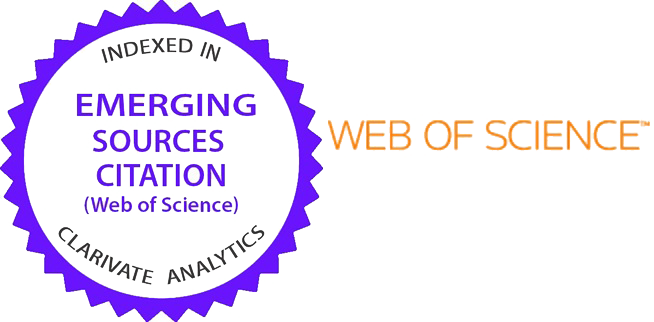Machine Learning Models for Predicting the Compressive Strength of Concrete with Shredded PET Bottles and M-Sand as Fine Aggregate
DOI:
https://doi.org/10.31436/iiumej.v26i1.2998Keywords:
Machine learningAbstract
Machine Learning (ML) and Artificial Intelligence (AI) are closely intertwined and represent the latest cutting-edge technologies that facilitate the development of intelligent prototypes. Machine learning is a critical subset of AI that deliberates the development of self-trained algorithms that use previous databases and analysis for result predictions. By leveraging past data, machine learning empowers computers to make predictions and decisions. This study investigates the use of ML algorithms to predict the compressive strength of grade 30 concrete, incorporating shredded PET bottles and M-sand as fine aggregates. The experimental setup involved preparing concrete specimens with shredded PET bottle aggregates, varying the volume from 0% to 2% in increments of 0.5%. Different percentages of M-sand were incorporated at 25%, 50%, 75%, and 100%. The mixing proportions adhered to the standards defined by the Department of Environment (DOE). Cubic specimens were cast and cured for 7, 28, and 90 days. The study employs Multiple Linear Regression (MLR), Artificial Neural Network (ANN), and Decision Tree (DT) models, using the experimental data for predictive analysis. The evaluation of the three models for predicting compressive strength yielded interesting results: The Decision Tree (DT) model demonstrated the best performance, with a relatively low Mean Squared Error (MSE) of 5.125 and Mean Absolute Error (MAE) of 1.642 and a high R² value of 0.918, indicating that the model explains approximately 91.8% of the variance in the target variable. The DT model's ability to handle complex, non-linear data relationships made it particularly effective in evaluating concrete strength. The Multiple Linear Regression (MLR) model provided reasonable predictions but showed higher errors compared to the DT model, with MSE and MAE values of 26.663 and 4.298, respectively, and an R² score of 0.571, demonstrating a moderate ability to explain the variance in the data. Conversely, the Artificial Neural Network (ANN) model exhibited the least accuracy, with the highest errors (MSE of 112.33 and MAE of 8.52) and a negative R² score (-0.64), indicating poor model training and an inability to capture the relationships between parameters effectively, partly due to the relatively small dataset. The study highlights the potential of DT models in sustainable construction practices, emphasizing the importance of comprehensive datasets and further exploration of alternative algorithms. The findings advocate for using ML in concrete strength prediction, contributing to advancements in sustainable engineering and material science.
ABSTRAK: Pembelajaran Mesin (ML) dan Kecerdasan Buatan (AI) saling berkait rapat dan mewakili teknologi canggih terkini yang membantu pembangunan prototaip pintar. Pembelajaran mesin adalah subset kritikal AI yang menumpukan pada pembangunan algoritma dilatih sendiri menggunakan pangkalan data dan analisis terdahulu bagi meramal hasil. Dengan memanfaatkan data masa lalu, pembelajaran mesin memberi kuasa kepada komputer bagi membuat ramalan dan keputusan. Kajian ini menyelidik penggunaan algoritma ML bagi meramalkan kekuatan mampatan konkrit gred 30, menggabungkan botol PET yang dicincang dan pasir-M sebagai agregat halus. Susunan eksperimen melibatkan penyediaan spesimen konkrit dengan agregat botol PET yang dicincang, memvariasikan isipadu dari 0% hingga 2% dalam kenaikan 0.5%. Peratusan berbeza bagi pasir-M telah digabungkan pada 25%, 50%, 75%, dan 100%. Nisbah campuran mematuhi piawaian yang ditetapkan oleh Jabatan Alam Sekitar (DOE). Spesimen kubik dipadatkan dan diawetkan selama 7, 28, dan 90 hari. Kajian ini menggunakan model Regresi Linear Berganda (MLR), Rangkaian Neural Buatan (ANN), dan Pokok Keputusan (DT), manakala data eksperimen digunakan bagi analisis ramalan. Penilaian terhadap tiga model bagi meramal kekuatan mampatan menghasilkan keputusan yang menarik: Model Pokok Keputusan (DT) menunjukkan prestasi terbaik, dengan Ralat Kuasa Dua Min (MSE) yang agak rendah iaitu 5.125 dan Ralat Mutlak Min (MAE) 1.642, serta nilai R² yang tinggi iaitu 0.918, menunjukkan bahawa kira-kira 91.8% daripada model varian ini dalam pemboleh ubah sasaran. Keupayaan model DT bagi mengurus data kompleks dan tidak linear menjadikannya sangat berkesan dalam menilai kekuatan konkrit. Model Regresi Linear Berganda (MLR) memberi ramalan munasabah tetapi menunjukkan ralat lebih tinggi berbanding model DT, dengan nilai MSE dan MAE masing-masing 26.663 dan 4.298, dan skor R² 0.571, menunjukkan keupayaan sederhana bagi menjelaskan varians data. Sebaliknya, model Rangkaian Neural Buatan (ANN) menunjukkan ketepatan paling rendah, dengan ralat tertinggi (MSE 112.33 dan MAE 8.52) dan skor R² negatif (-0.64), yang menunjukkan latihan model yang lemah dan ketidakmampuan menangkap hubungan antara parameter dengan berkesan, sebahagiannya disebabkan oleh dataset yang kecil. Kajian ini menekankan potensi model DT dalam amalan pembinaan lestari, menekankan kepentingan dataset yang komprehensif dan penerokaan lanjut mengenai algoritma alternatif. Dapatan kajian menyokong penggunaan ML dalam ramalan kekuatan konkrit, menyumbang kepada kemajuan dalam kejuruteraan lestari dan sains bahan.
Downloads
Metrics
References
Saikia, N., & De Brito, J. (2012). Use of plastic waste as aggregate in cement mortar and concrete preparation: A review. Construction and Building Materials, 34, 385-401. https://doi.org/10.1016/j.conbuildmat.2012.02.066 DOI: https://doi.org/10.1016/j.conbuildmat.2012.02.066
Shahidan, S., Ranle, N. A., Zuki, S. S. M., Khalid, F. S., Ridzuan, A. R. M., &Nazri, F. M. (2018). Concrete incorporated with optimum percentages of recycled polyethylene terephthalate (PET) bottle fiber. International Journal of Integrated Engineering, 10(1), 1-8. DOI: https://doi.org/10.30880/ijie.2018.10.01.001
Ochi, T., Okubo, S., & Fukui, K. (2007). Development of recycled PET fiber and its application as concrete-reinforcing fiber. Cement and Concrete Composites, 29(6), 448-455. https://doi.org/10.1016/j.cemconcomp.2007.02.002 DOI: https://doi.org/10.1016/j.cemconcomp.2007.02.002
Alqahtani, F. K., Ghataora, G., Khan, M. I., &Dirar, S. (2017). Novel lightweight concrete containing manufactured plastic aggregate. Construction and Building Materials, 148, 386-397. https://doi.org/10.1016/j.conbuildmat.2017.05.011 DOI: https://doi.org/10.1016/j.conbuildmat.2017.05.011
Manju, M., & K, A. N. (2016). Durability Studies on Concrete by Replacing Natural Sand with M-Sand-A Review. International Journal of Emerging Technology and Advanced Engineering, 6(3), 3-7.
Cheah, C. B., Lim, J. S., &Ramli, M. B. (2019). The mechanical strength and durability properties of ternary blended cementitious composites containing granite quarry dust (GQD) as natural sand replacement. Construction and Building Materials, 197, 291-306. https://doi.org/10.1016/j.conbuildmat.2018.11.194 DOI: https://doi.org/10.1016/j.conbuildmat.2018.11.194
Meisuh, B. K., Kankam, C. K., &Buabin, T. K. (2018). Effect of quarry rock dust on the flexural strength of concrete. Case Studies in Construction Materials, 8(July 2017), 16-22. https://doi.org/10.1016/j.cscm.2017.12.002 DOI: https://doi.org/10.1016/j.cscm.2017.12.002
Shen, W., et. al. (2018). Influence of manufactured sand’s characteristics on its concrete performance. Construction and Building Materials, 172(May), 574-583. https://doi.org/10.1016/j.conbuildmat.2018.03.139 DOI: https://doi.org/10.1016/j.conbuildmat.2018.03.139
Cihan, M. T. (2019). Prediction of Concrete Compressive Strength and Slump by Machine Learning Methods. Advances in Civil Engineering, 2019. https://doi.org/10.1155/2019/3069046 DOI: https://doi.org/10.1155/2019/3069046
Heath, N. (2020). What is machine learning? Everything you need to know. Retrieved from https://www.zdnet.com/article/what-is-machine-learning-everything-you-need-to-know/
Chopra, P., Sharma, R. K., & Kumar, M. (2016). Prediction of Compressive Strength of Concrete Using Artificial Neural Network and Genetic Programming. Advances in Materials Science and Engineering, 2016. https://doi.org/10.1155/2016/7648467 DOI: https://doi.org/10.1155/2016/7648467
Dantas, A. T. A., Leite, M. B., &Nagahama, K. D. J. (2013). Prediction of compressive strength of concrete containing construction and demolition waste using artificial neural networks. Construction and Building Materials, 38, 717-722. https://doi.org/10.1016/j.conbuildmat.2012.09.026 DOI: https://doi.org/10.1016/j.conbuildmat.2012.09.026
Chithra, S., Kumar, S. R. R. S., Chinnaraju, K., &Ashmita, F. A. (2016). A comparative study on the compressive strength prediction models for High Performance Concrete containing nano silica and copper slag using regression analysis and Artificial Neural Networks. Construction and Building Materials, 114, 528-535. https://doi.org/10.1016/j.conbuildmat.2016.03.214 DOI: https://doi.org/10.1016/j.conbuildmat.2016.03.214
Silva, P. F. S., Moita, G. F., &Arruda, V. F. (2020). Machine learning techniques to predict the compressive strength of concrete. RevistaInternacional de MétodosNuméricos para Cálculo y DiseñoenIngeniería, 1-14. https://doi.org/10.23967/j.rimni.2020.09.008 DOI: https://doi.org/10.23967/j.rimni.2020.09.008
Cherickal, P. J., Kumar, V. V., Philipose, R. M., Shailesh, S., & Thomas, T. (2021). Compression Strength Prediction Using Machine Learning Techniques. International Journal of Advanced Trends in Computer Science and Engineering, 10, 301-307. https://doi.org/10.30534/ijatcse/2021/431012021 DOI: https://doi.org/10.30534/ijatcse/2021/431012021
Koyaa, R. G., &Bhanu, C. V., &Aneja, S., P. (2021). Comparative analysis of different machine learning algorithms to predict mechanical properties of concrete. Mechanics of Advanced Materials and Structures. DOI: https://doi.org/10.1080/15376494.2021.1917021
Hameed, M. M., Abed, M. A., Al-Ansari, N., & Alomar, M. K. (2022). Predicting Compressive Strength of Concrete Containing Industrial Waste Materials: Novel and Hybrid Machine Learning Model. Advances in Civil Engineering, 2022. https://doi.org/10.1155/2022/5586737 DOI: https://doi.org/10.1155/2022/5586737
El-Mir, A., El-Zahab, S., Sbartaï, Z. M., Homsi, F., Saliba, J., & El-Hassan, H. (2023). Machine learning prediction of concrete compressive strength using rebound hammer test. Journal of Building Engineering, 64(July 2022), 105538. https://doi.org/10.1016/j.jobe.2022.105538 DOI: https://doi.org/10.1016/j.jobe.2022.105538
Wang, W., & Lu, Y. (2018). Analysis of the Mean Absolute Error (MAE) and the Root Mean Square Error (RMSE) in Assessing Rounding Model. IOP Conference Series: Materials Science and Engineering, 324(1), 012049. https://doi.org/10.1088/1757-899X/324/1/012049 DOI: https://doi.org/10.1088/1757-899X/324/1/012049
Chai, T., &Draxler, R. R. (2014). Root mean square error (RMSE) or mean absolute error (MAE)? – Arguments against avoiding RMSE in the literature. Geoscientific Model Development, 7(3), 1247-1250. https://doi.org/10.5194/gmd-7-1247-2014 DOI: https://doi.org/10.5194/gmd-7-1247-2014
Agrawal. (2021). Know The Best Evaluation Metrics for Your Regression Model!. Retrieved from https://www.analyticsvidhya.com/blog/2021/05/know-the-best-evaluation-metrics-for-your-regression-model/
Varshini, A. G. P., Kumari, K. A., Janani, D., &Soundariya, S. (2021). Comparative analysis of Machine learning and Deep learning algorithms for Software Effort Estimation. Journal of Physics: Conference Series, 1767(1), 012019. https://doi.org/10.1088/1742-6596/1767/1/012019 DOI: https://doi.org/10.1088/1742-6596/1767/1/012019
Nadimalla, A. ., Masjuki, S. ., Saad, S. ., & Ali, M. (2022). Machine Learning Model to Predict Slump, VEBE and Compaction Factor of M Sand and Shredded Pet Bottles Concrete. IOP Conference Series: Materials Science and Engineering, 1244(1), 012023. https://doi.org/10.1088/1757-899x/1244/1/012023 DOI: https://doi.org/10.1088/1757-899X/1244/1/012023
Chopra, P., Sharma, R. K., Kumar, M., & Chopra, T. (2018). Comparison of Machine Learning Techniques for the Prediction of Compressive Strength of Concrete. Advances in Civil Engineering, 2018. https://doi.org/10.1155/2018/5481705 DOI: https://doi.org/10.1155/2018/5481705
Downloads
Published
How to Cite
Issue
Section
License
Copyright (c) 2024 IIUM Press

This work is licensed under a Creative Commons Attribution-NonCommercial 4.0 International License.






















